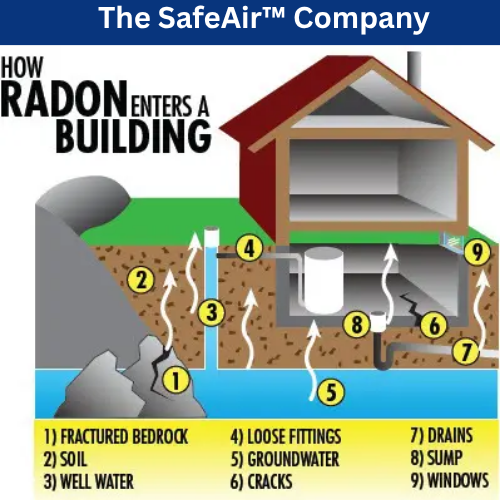Los Angeles, a sprawling metropolis defined by its vibrant economy and diverse urban landscape, is home to countless commercial enterprises and bustling multifamily residential complexes. From towering office buildings and retail centers to expansive apartment complexes and essential healthcare facilities, these properties are the backbone of the city’s activity. Yet, beneath their foundations lies an invisible threat that demands proactive attention: radon gas. For property owners, managers, and developers, understanding and addressing this silent hazard through comprehensive Commercial & Multifamily Radon Testing in Los Angeles is not just a best practice—it’s a critical component of responsible property management and occupant safety.
The Invisible Threat in High-Occupancy Environments
Radon is a naturally occurring radioactive gas that forms from the breakdown of uranium found in soil, rock, and water. It’s insidious because it’s odorless, colorless, and tasteless, making it undetectable without specialized equipment. . Once inside an enclosed space, it can accumulate to dangerous concentrations. Prolonged exposure to elevated radon levels is the second leading cause of lung cancer in the United States, after smoking.
In the context of Los Angeles’s commercial and multifamily properties, the risk is amplified by high occupancy rates. Unlike a single-family home, these buildings house hundreds, sometimes thousands, of individuals daily – employees, customers, students, patients, or long-term residents. This increases the collective exposure risk and, consequently, the potential for long-term health consequences for a significant population. While Los Angeles County has varying radon potential zones, certain areas within the greater LA region have demonstrated indoor radon concentrations exceeding the EPA’s recommended action level of 4.0 pCi/L, making proactive Commercial & Multifamily Radon Testing in Los Angeles a prudent decision across the board.
Unique Challenges in Commercial & Multifamily Testing
Testing commercial and multifamily structures presents distinct challenges compared to single-family homes. These properties often feature complex HVAC systems, multiple entry points for occupants and services, diverse foundation types (from deep basements to slab-on-grade), and varying occupancy patterns across numerous units or zones.
California now mandates that radon testing services adhere to the stringent ANSI/AARST standards. Meeting these comprehensive requirements for a large apartment complex or sprawling office park demands meticulous planning, logistical expertise, and significant coordination. Challenges such as obtaining tenant access, maintaining “closed-building conditions” during testing periods, and ensuring the accurate placement and retrieval of numerous testing devices require specialized knowledge and experience unique to Commercial & Multifamily Radon Testing in Los Angeles.
Protecting People, Property, and Reputation
For property owners and managers, conducting regular Commercial & Multifamily Radon Testing in Los Angeles is a fundamental aspect of risk management. Beyond the paramount concern for human health, elevated radon levels can lead to significant liabilities, potentially impacting property values, insurance costs, and overall marketability. Proactive testing and, if necessary, mitigation demonstrate a commitment to occupant well-being, fostering trust with tenants, employees, and investors.
Identifying and addressing radon issues helps to:
- Safeguard Occupant Health: Directly reduces the risk of radon-induced lung cancer for all building occupants.
- Mitigate Legal & Financial Risks: Protects against potential lawsuits related to health hazards and preserves property value by avoiding costly emergency remediation.
- Enhance Property Value & Reputation: A building with documented low radon levels or a successfully mitigated system offers peace of mind and is a more attractive, responsible investment.
- Ensure Regulatory Compliance: Adhering to the latest ANSI/AARST standards for testing ensures that the property meets industry best practices and potential future regulatory requirements.
The Professional Testing Process
Engaging certified professionals for Commercial & Multifamily Radon Testing in Los Angeles is non-negotiable. These experts possess the necessary certifications (e.g., NRPP, NRSB) and adhere to industry protocols for accurate measurement in large, complex structures. The process typically involves:
- Strategic Device Placement: Multiple short-term or long-term radon detectors are placed throughout the building, specifically targeting ground-contact units, high-occupancy areas, and a percentage of upper floors as per standards.
- Controlled Conditions: Ensuring “closed-building conditions” (keeping windows and doors closed as much as possible) for the duration of the test to capture accurate indoor radon concentrations.
- Laboratory Analysis: Devices are sent to an accredited laboratory for precise measurement of radon levels.
- Comprehensive Reporting & Recommendations: A detailed report outlines findings, identifies any elevated levels, and provides clear, actionable recommendations for mitigation strategies if needed, such as sub-slab depressurization or enhanced ventilation. Follow-up testing is then crucial to confirm the success of any mitigation efforts.
In a city as dynamic as Los Angeles, prioritizing proactive Commercial & Multifamily Radon Testing in Los Angeles is an investment in the health and safety of its communities and the long-term viability of its valuable properties. It’s a commitment to ensuring that every building provides a truly safe and healthy environment for everyone inside.









